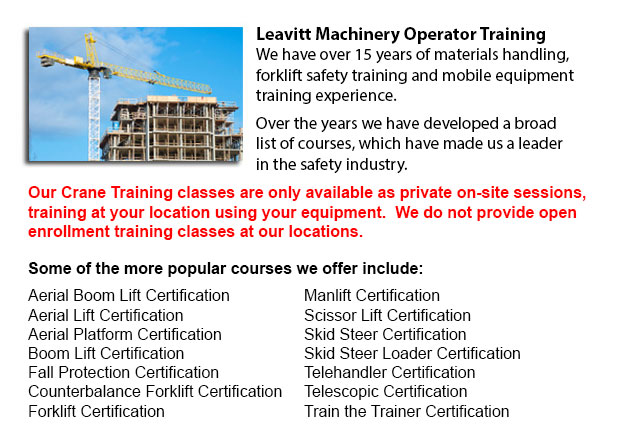
Overhead Crane Safety Training Kelowna - The overhead crane safety training course is designed to equip the operators with the right knowledge and skills in the areas of: crane safety measures, accident avoidance, materials handling, and equipment and stock protection. Each of the trainees will get to learn about numerous kinds of overhead cranes, their capabilities and their uses in different settings. For operators who are trained and licensed, the shift in liability moves from the company to the operator. Therefore, the program emphasizes individual operator duties.
Overhead crane safety training instructs operators in the proper ways for carrying out inspections. Two kinds of pre-shift check are the in-depth inspection and the walk-around inspection. These are critical daily routines that must be logged. Properly recorded pre-shift checks help to protect the business from liability in case of an accident. Pre-shift checks also prevent damage, costly repairs and accidents. Operators learn how to designate a particular person to carry out checks, how to maintain the log book and how to report problems.
Inspections should be done frequently and documented right. The following should inspected while watching for common problems: increase in the throat opening, hooks for cracks, degree of twist; hoist ropes for corrosion, worn wires, loss of diameter, bird caging and kinks, broken wires, chains for nicks and gouges, heat and chemical damage, corrosion and cracks, twists, excessive wear, distortion, pits, stretching, damage caused by extreme heat.
The operator would get to learn the right methods about correct rigging procedures. The process of rigging includes the understanding of the manufacturer's data plate, determining the weight of materials to be lifted, selecting the gear, and utilizing safe practices to secure the load. The program cover in detail the following: safe working loads, and the capacities of chains, ropes, shackles, slings and hooks.
It is vital to know who could use the cranes at your facility, the job's physical requirements, and operator qualifications required for specialized job and permits. Safety is a priority when operating near pedestrian traffic.
The duties involved in the safe crane use includes undertaking visual inspections, checking for hydraulic leaks, checking the safety guards, testing the controls, examining the hoist rope and hook, limit switches and braking mechanisms. Proper reporting procedures are important. These topics are all included in depth in the course.
Proper moving and lifting methods with hoists and cranes are included in the course. Operators will become competent in hand signals. Training includes how to raise the load, attach the load, unhook the slings, abort a lift and set the load.
Moving the load includes several steps: stopping and starting procedures, guiding and controlling the load, observing working conditions and working with signals. Operators should know how to proceed in the event of a power failure. The program includes methods for lowering the load and removing the slings, storage of equipment, parking the crane, and securing an outdoor and indoor crane.
-
Counterbalance Forklift License Kelowna
Counterbalance Forklift License Kelowna - Forklifts, when operated by completely trained workers, are a major advantage to companies. We offer a thorough training program consisting of all parts of operating a powered lift device. Counterbalance fork... More -
Forklift Certification Schools Kelowna
Forklift Certification Schools Kelowna - Within North America, forklift certification is mandatory, making forklift training programs important for both the company and their employees working as forklift operators. Forklift training focuses on healt... More -
Manlift Operator Certification Kelowna
Manlift Operator Certification Kelowna - We provide a scissor platform and aerial lift training and certification to empower the trainee with the general understanding and knowledge of the safe and efficient utilization of "Power Operated Mobile Work... More -
Crane Training Schools Kelowna
Crane Training Schools Kelowna - We have designed several programs for Mobile Crane Operation at our Crane Training Schools. These programs are recommended for the experienced operator who requires re-certification or certification, and for inexperie... More -
Heavy Equipment Operator Classes Kelowna
Heavy Equipment Operator Classes Kelowna - A heavy equipment operator is a person who has received the proper training to operate a particular type or piece of machine. There are a lot of ways for the operator to undergo training and certification in... More -
Telehandler, Rotational Telehandler, Zoom Boom Training in Kelowna
Telehandlers or also known as Telescopic handlers are really popular piece of heavy construction equipment normally utilized in agriculture and construction trades. These equipments have extreme reaching capability and could get to places where a tra... More -
Zoom Boom Training Kelowna
Zoom Boom Training Kelowna - Zoom Boom Training is intended to train operators on variable reach forklifts. The goals of the training are to impart an understanding of the physics of the equipment, and to outline the operator's tasks. This course fol... More -
Boom Lift Safety Training Kelowna
Boom Lift Safey Training Kelowna - Boom lifts fall under the type of elevated work platform or aerial lifting device. Most normally utilized in construction, industry, and warehousing; the boom lift is so versatile that it can be utilized in almost w... More

Forklift Training Kelowna
TOLL FREE: 1-888-254-6157
Kelowna, British Columbia
forklifttraininginkelowna.com
Email Us
About Us


